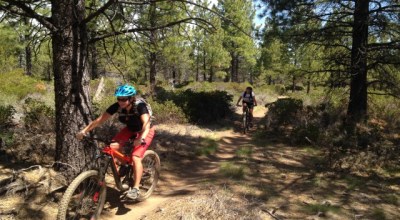Local trail associations play critical role in trail networks
Published 4:00 pm Wednesday, August 7, 2024

- A team of volunteers prepares to do maintenance on Todd Lake Trail.
We are lucky to have such a robust trail network throughout Central Oregon.
Hiking trails to lakes and mountain tops, equestrian trails for single and multi-day adventures, nordic trails for fitness and nature pursuits, moto and ATV routes to get the adrenaline flowing, groomed snowmobile corridors for scenery, and over 600 miles of singletrack for mountain biking. Most of these paths are on federal lands, and most are built and maintained not by our tax dollars but by local trail associations.
Yes, your tax dollars largely do not fund trails on our National Forest and Bureau of Land Management lands. It’s not that these agencies don’t care about recreation, but rather that their budgets are tight and largely consumed by wildfire management. This is where partnerships with trail associations step in. A trail group like Central Oregon Trail Association (COTA) will enter into a Volunteer Agreement to build and maintain trails on federal lands. The land manager may help out with labor or contribute funds for a specific project like signage, but the trail association largely raises the funds for trail projects and does the labor themselves.
Deadfall and drainage
After a trail is built, what more is there to do? Most trails require annual maintenance. Our soil is mostly sandy and sparse in microorganisms, which means it does not hold water well and is challenging for most ground-stabilizing plants to grow in. Because of this, when it rains or during seasonal melt off, water runs on the surface and transports sandy soil with it. This will create deep ruts down trails and make sandboxes of flat trails. Trail associations annually assess and correct drainage issues along every mile of trail.
Manzanita and snowbrush both grow rapidly and clog trails, and the only reason you can see the trails in many areas is these are brushed (pruned) annually by volunteers. Our forests are dense, and trees fall across trails in the hundreds annually. COTA has a volunteer sawyer crew that logs out this deadfall. If a tree falls in the forest, you can bet the sawyers heard it and are on their way.
Professional mountain biker looks at the pros of e-bikes
In addition to care needed on trails to repair natural disturbances, trail associations will address human caused issues as well. Eliminating corner cutting, reducing trail widening and decommissioning unapproved user-made tracks to name a few are all part of the work required by land managers for the trail associations. Trail groups also install and maintain signage, keep up trailhead areas, ensure gates and fences are intact, and even build bridges.
Winter trail networks like the Wanoga Fat Bike Park require special snow grooming equipment. This specialized equipment is expensive, requires a lot of maintenance and fuel to run, and is operated by specially trained volunteer who typically groom in the wee hours of the night in freezing conditions. For many, this work is a passion project.
Where trail failures lead
When a trail association does not take care of a trail, it is shocking how quickly the trail degrades. They may form deep trenches where water has eroded the trail away and fill with deep sand. Trails can get so overgrown you cannot see where it goes or even walk down it. Over a hundred trees may fall across a trail in a single mile, making it an obstacle course rather than a trail. A spiderweb of social trails can crop up, damaging wilderness and making it difficult to figure out where the trail really goes. Trails can widen to the point they are more a road than a trail which is not a very interesting wilderness experience for users. Signage vanishes, and getting lost becomes a real possibility. Eventually, the trail is abandoned because it is not enjoyable to use.
Ways to help
There is a lot of work done by trail associations on all of the trails you use, and without it we would not have trails. While trails are for everyone to use free of charge, there is a big cost to ensure we have fun trails, and that they will endure for generations. COTA estimates that it cost $5 per foot of trail to maintain, and with over 600 miles of trails in their care, that’s $1.6 million!
Try these cool rides for hot summer mountain biking
It is easy to find out which trail association has the volunteer agreement for the trails you frequent. Trailhead kiosks typically list the group that stewards the trails, and most trail apps list this as well. Become a member of that organization. A robust member base shows the land manager that this user group supports the trails. If you can’t volunteer your time, consider a donation. Is a day spent recreating on trails worth $5 to you? That donation is essential to keep the recreation we love in Central Oregon recreation we love.
More Biking





